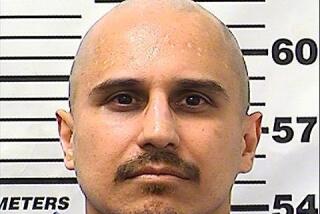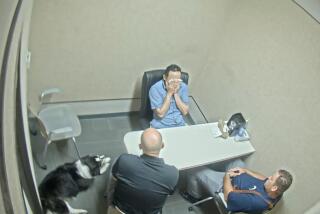Officer in Zimmerman murder trial describes trying to save Trayvon Martin
- Share via
Jurors got their first taste of the forensic details of how Trayvon Martin died at the hands of George Zimmerman, as the prosecution in the controversial Florida murder case began to present the nuts and bolts of the argument that it hopes will sway the jury.
On Monday, the prosecution presented its first witnesses and concentrated on emergency telephone calls made by Zimmerman, charged with second-degree murder in the shooting of Martin. On Tuesday, the mood shifted as the prosecution emphasized the physical details of the night of Feb. 26, 2012.
Police Sgt. Anthony Raimondo, one of the first officers to respond to reports of a shooting at a gated community in Sanford, Fla., described how he provided mouth-to-mouth resuscitation and searched for an exit wound in hopes of stanching the blood flow and saving the teenager’s life.
When he arrived, Raimondo said, Martin was on the ground and Zimmerman was handcuffed nearby.
The sergeant said Martin was not moving and did not make a sound. The officer said he bent down and tried to detect a pulse on Martin’s neck, but found none. Then he rolled Martin over onto his back.
“I breathed for Mr. Martin, or tried to,” he said, describing how he gave mouth-to-mouth resuscitation as another officer began performing chest compressions on Martin. Asked whether Raimondo heard anything coming from Martin, he replied, “Bubbling sounds.”
“It meant either air was getting into or escaping from the chest in a manner it was not supposed to,” Raimondo testified.
The sergeant said he called out to the gathering crowd to help by giving him plastic wrap and Vaseline to try to seal the chest wound. He said he lifted Martin into a sitting position to find the exit wound and seal it, but he did not find the wound. He did, however, feel a cold can — the soft drink Martin had just bought — in the pocket of his hoodie.
Raimondo said he lay Martin back down and resumed CPR. Rescue workers arrived and hooked Martin up to an EKG machine, but then pronounced the teenager dead. Raimondo said he put a blanket over Martin’s body out of “respect for the deceased” as well as to preserve evidence and to limit trauma to relatives who might come upon the scene.
Prosecutor John Guy showed Raimondo, and the six-woman jury, a photograph of Martin lying facedown in the grass, his hands underneath him. Close-up pictures of the bullet hole that pierced Martin’s chest were shown later, along with photos of the slain teenager’s face and hands and the bloody hole in his shirt.
Martin’s father, Tracy, left the courtroom when the graphic photos were shown. The family lawyer, Daryl Parks, could be seen comforting Martin’s mother, Sybrina Fulton, on images broadcast from the Seminole County courtroom.
Zimmerman, 29, has said he shot Martin, 17, in self-defense. The former neighborhood watch volunteer says he saw Martin walking in the housing complex and called police saying there was a suspicious person. The dispatcher who took that call testified Monday that he had advised, but had not ordered, Zimmerman to let police handle the situation.
On Tuesday, the second day of witness testimony, Wendy Dorival of the Sanford Police Department described the protocols under which neighborhood watch groups operated. Her testimony goes to the prosecution’s contention that Zimmerman should have let police deal with the situation. In his opening statement, prosecutor Guy argued that Zimmerman profiled, confronted and shot the African American teenager not because he had to, but because he wanted to. Zimmerman identifies himself as Latino.
Dorival, a civilian with the Sanford Police Department, was volunteering as a coordinator because she believed in neighborhood watch programs. In fall 2011, she visited Zimmerman and other residents at the housing complex to discuss setting up a watch program.
“Their duty is to be the eyes and ears, report crime as they see it,” said Dorival, adding that she provided handouts emphasizing this and also verbally explained it during the meeting. Zimmerman was there as the neighborhood watch coordinator. Guy asked Dorival what her instructions tell volunteers to do if they begin following a suspicious person.
“We tell them they don’t do that. That’s the job of law enforcement,” she replied.
The same instructions apply to confronting a suspicious person, Dorival said. Her presentation, she said, would advise people “not to confront; to let … the Police Department do the job.”
“They’re not supposed to take matters into their own hands.... Let law enforcement take the risk of approaching a suspect,” she said.
Under cross-examination by defense attorney Don West, Dorival said Zimmerman “was very professional” with her.
“He seemed a little meek to me,” she said. “He seemed like he really wanted to make changes in his community to make it better.”
More to Read
Sign up for Essential California
The most important California stories and recommendations in your inbox every morning.
You may occasionally receive promotional content from the Los Angeles Times.












